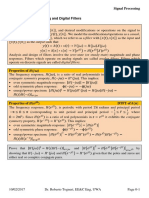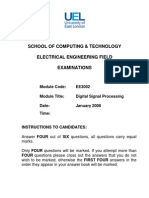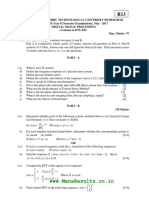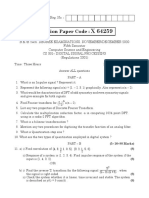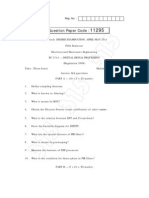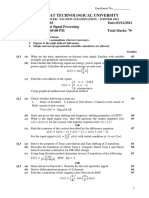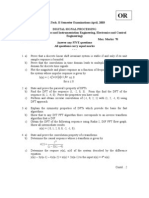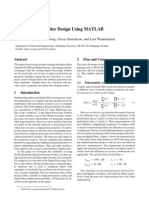0 ratings0% found this document useful (0 votes)
13 viewsDTSP - Assignment No.2
The document is an assignment on discrete time signal processing covering topics such as digital filtering, frequency warping, bilinear and impulse invariant transformations, filter realizations, and filter design. It contains 5 questions with subparts requiring explanations, definitions, derivations, comparisons, and filter designs.
Uploaded by
BHAVESH PATILCopyright
© © All Rights Reserved
Available Formats
Download as DOCX, PDF, TXT or read online on Scribd
0 ratings0% found this document useful (0 votes)
13 viewsDTSP - Assignment No.2
The document is an assignment on discrete time signal processing covering topics such as digital filtering, frequency warping, bilinear and impulse invariant transformations, filter realizations, and filter design. It contains 5 questions with subparts requiring explanations, definitions, derivations, comparisons, and filter designs.
Uploaded by
BHAVESH PATILCopyright
© © All Rights Reserved
Available Formats
Download as DOCX, PDF, TXT or read online on Scribd
You are on page 1/ 2
MGM’s College of Engineering and Technology
Kamothe, Navi Mumbai
Assignment No. 2 [A.Y. 2023-24]
Department: EXTC Class: T.E.(Sem.V)
Subject: Discrete Time Signal Processing (ECC-502)
Date of issue: 30/09/2023 Date of submission: 10/10/2023
Q.No Question Module Bloom’s PI CO
Taxanom
y level
Q1. Name the following or define or design the following
a) Explain concept of digital filtering. Also list types of 2 2 6.1.1 2
A digital filter.
b) What is meant by frequency warping? What is the cause 2 2 3.2.1 2
B of this effect?
c) Write the transformation formula for 2 2 5.1.1 2
C i) The bilinear transformation.
ii) The impulse invariant transformation.
Q2. Answer the following questions in brief (20 to 30 words)
a) Explain ideal filter characteristics of low pass, high 2 3 5.1.1 2
A pass, band pass, and band stop filter.
b) State advantages and disadvantage of impulse invariant 2 3 6.1.1 2
B mapping technique.
c) A digital filter is described by the following difference 2 3 6.1.1 2
equation
y(n)=0.9y(n-1)+bx(n)
i) Determine b such that H(0)= 1
ii) Identify the filter type based on pass band.
d) State advantages and disadvantage of bilinear mapping 2 4 3.2.1 2
C technique.
. Q3. Answer the following questions in brief (50 to 70
words)
a) Compare impulse invariant and bilinear transformation 2 3 5.1.2 2
A methods.
b) Obtain direct form-I and direct Form II realizations of 4 3 3.2.1 4
B the system function
−1 −2
1+2 z −z
H ( z )= −1 −2
1+ z −z
c) An LTI system is described by the difference equation 4 3 3.2.1 4
C y ( n )=a1 y ( n−1 ) + x ( n )+ b1 x (n−1)
Q4. Think and Answer
a) Use bilinear transformation to convert an analog filter 2 3 5.1.2 2
with system function
s+0.1
H ( s )=
( s +0.1 )2 +9
Into a digital IIR filter. Select T = 0.1 sec and compare
the locations of the zeros in H(z) with the locations of
the zeros obtained by applying the impulse invariant
method in the conversion of H(s).
b) Determine the system function H(z) of the lowest order 2 4 5.2.1 2
Chebyshev and Butterworth digital filter with following
specifications:
a) 3 dB ripple in the pass band
0 ≤ ω ≤ 0.2 π
b) At least 25 dB attenuation in the stop band
0.45 π ≤ω ≤ π
Use bilinear transformation.
c) Obtain cascade and parallel realization of the given LTI 4 5 6.2.1 4
system governed by the difference equation
5 1
y ( n )= y ( n−1 )− y ( n−2 ) + x ( n )−3 x ( n−1 ) +3 x ( n−2 )−x ( n−3)
8 16
Q5. My Ideas
a) Design a digital Butterworth filter to meet the constraint 2 5 4.6.1 2
0.8 ≤|H ( e )|≤1 , 0 ≤ ω ≤0.2 π
jω
|H ( e jω )|≤ 0.2 ,0.26 π ≤ ω ≤ π
Using i) bilinear transformation; and ii) impulse
invariant transformation.
b) Design a digital Chebyshev filter to meet the constraint 2 5 4.6.1 2
0.8 ≤|H ( e )|≤1 , 0 ≤ ω ≤0.2 π
jω
|H ( e jω )|≤ 0.2 ,0.6 π ≤ ω ≤ π
Using i) bilinear transformation; and ii) impulse
invariant transformation.
c) Obtain direct form-I, direct form-II, cascade and parallel 4 5 6.2.1 4
form realizations for following system
y ( n )=−0.1 y ( n−1 ) +0.72 y ( n−2 ) +0.7 x ( n )−0.25 x ( n−2 )
*As per 1Blooms’ Taxonomy
********
You might also like
- Hourglass Workout Program by Luisagiuliet 276% (21)Hourglass Workout Program by Luisagiuliet 251 pages
- The Hold Me Tight Workbook - Dr. Sue Johnson100% (16)The Hold Me Tight Workbook - Dr. Sue Johnson187 pages
- Read People Like A Book by Patrick King-Edited62% (66)Read People Like A Book by Patrick King-Edited12 pages
- Livingood, Blake - Livingood Daily Your 21-Day Guide To Experience Real Health77% (13)Livingood, Blake - Livingood Daily Your 21-Day Guide To Experience Real Health260 pages
- COSMIC CONSCIOUSNESS OF HUMANITY - PROBLEMS OF NEW COSMOGONY (V.P.Kaznacheev,. Л. V. Trofimov.)94% (212)COSMIC CONSCIOUSNESS OF HUMANITY - PROBLEMS OF NEW COSMOGONY (V.P.Kaznacheev,. Л. V. Trofimov.)212 pages
- Donald Trump & Jeffrey Epstein Rape Lawsuit and Affidavits83% (1016)Donald Trump & Jeffrey Epstein Rape Lawsuit and Affidavits13 pages
- The 36 Questions That Lead To Love - The New York Times94% (34)The 36 Questions That Lead To Love - The New York Times3 pages
- The 36 Questions That Lead To Love - The New York Times95% (21)The 36 Questions That Lead To Love - The New York Times3 pages
- Jeffrey Epstein39s Little Black Book Unredacted PDF75% (12)Jeffrey Epstein39s Little Black Book Unredacted PDF95 pages
- The 4 Hour Workweek, Expanded and Updated by Timothy Ferriss - Excerpt23% (954)The 4 Hour Workweek, Expanded and Updated by Timothy Ferriss - Excerpt38 pages
- Department of Electrical Engineering National Institute of Technology Srinagar Tutorial IIINo ratings yetDepartment of Electrical Engineering National Institute of Technology Srinagar Tutorial III3 pages
- 13926 - Year - B.E. Electronics & Communication-Telecommunication Engineering (Model Curriculum) Semester-V Subject - ET505M - Digital Signal ProcessinNo ratings yet13926 - Year - B.E. Electronics & Communication-Telecommunication Engineering (Model Curriculum) Semester-V Subject - ET505M - Digital Signal Processin2 pages
- COMSATS Institute of Information Technology: Terminal - Fall 2014No ratings yetCOMSATS Institute of Information Technology: Terminal - Fall 201410 pages
- Time: 3 Hours Total Marks: 70: Printed Pages:02 Sub Code:REC-503 Paper Id: 130508 Roll NoNo ratings yetTime: 3 Hours Total Marks: 70: Printed Pages:02 Sub Code:REC-503 Paper Id: 130508 Roll No2 pages
- FUNDAMENTALS OF DIGITAL SIGNAL PROCESSING-AEIE 3104-2022No ratings yetFUNDAMENTALS OF DIGITAL SIGNAL PROCESSING-AEIE 3104-20224 pages
- C F1048 Pages:2: Answer Any Two Full Questions, Each Carries 15 MarksNo ratings yetC F1048 Pages:2: Answer Any Two Full Questions, Each Carries 15 Marks2 pages
- Ec301 Digital Signal Processing June 2024No ratings yetEc301 Digital Signal Processing June 20242 pages
- HT TP: //qpa Pe R.W But .Ac .In: 2012 Control System-INo ratings yetHT TP: //qpa Pe R.W But .Ac .In: 2012 Control System-I7 pages
- Fundamentals of Digital Signal Processing (Aeie 3104)No ratings yetFundamentals of Digital Signal Processing (Aeie 3104)4 pages
- Set No. 1: Digital Control Systems RT42021No ratings yetSet No. 1: Digital Control Systems RT420218 pages
- Concepts of Fsdsdfsignal & Image ProcessingNo ratings yetConcepts of Fsdsdfsignal & Image Processing6 pages
- Digital Signal Processing (ECE 2203) PDFNo ratings yetDigital Signal Processing (ECE 2203) PDF2 pages
- Answer Any Two Full Questions, Each Carries 15 Marks: Reg No.: - NameNo ratings yetAnswer Any Two Full Questions, Each Carries 15 Marks: Reg No.: - Name2 pages
- EC6502-Principal of Digital Signal Processing - 2013 - Regulation PDFNo ratings yetEC6502-Principal of Digital Signal Processing - 2013 - Regulation PDF13 pages
- Name: Digital Logic Circuits (Common To ICE) Part A (20X2 40 Marks) Answer All QuestionsNo ratings yetName: Digital Logic Circuits (Common To ICE) Part A (20X2 40 Marks) Answer All Questions2 pages
- Robust Adaptive Control for Fractional-Order Systems with Disturbance and SaturationFrom EverandRobust Adaptive Control for Fractional-Order Systems with Disturbance and SaturationNo ratings yet
- Digital Signal Processing: Chapter 5: IIR Digital Filter DesignNo ratings yetDigital Signal Processing: Chapter 5: IIR Digital Filter Design156 pages
- Princom The Fundamentals of Electronics Module 2No ratings yetPrincom The Fundamentals of Electronics Module 29 pages
- 5th Sem Model Question Papers CBCS SchemeNo ratings yet5th Sem Model Question Papers CBCS Scheme20 pages
- Butterworth Filter Design With A Low Pass ButterworthNo ratings yetButterworth Filter Design With A Low Pass Butterworth8 pages
- Rigorous Design Method For Symmetric Reflectionless Filters With Arbitrary Prescribed Transmission ResponseNo ratings yetRigorous Design Method For Symmetric Reflectionless Filters With Arbitrary Prescribed Transmission Response8 pages
- Model 483C41 Eight-Channel ICP®/Voltage/Charge Sensor Signal Conditioner Installation and Operating ManualNo ratings yetModel 483C41 Eight-Channel ICP®/Voltage/Charge Sensor Signal Conditioner Installation and Operating Manual41 pages
- Introduction To RF Filter Design: RF Electronics Spring, 2018 Robert R. Krchnavek Rowan UniversityNo ratings yetIntroduction To RF Filter Design: RF Electronics Spring, 2018 Robert R. Krchnavek Rowan University47 pages
- Linear Block Code Decoding Using Neural Network: Kiran Maru Subham JadavNo ratings yetLinear Block Code Decoding Using Neural Network: Kiran Maru Subham Jadav3 pages
- ISRO 2012 Question Paper Along With Key For ECE (Electronics Department)70% (10)ISRO 2012 Question Paper Along With Key For ECE (Electronics Department)11 pages
- EC-704 Microwave Engineering: Lakshmi Narayan College of Technology & ScienceNo ratings yetEC-704 Microwave Engineering: Lakshmi Narayan College of Technology & Science32 pages
- Design of FIR Half-Band Filter With Controllable T PDFNo ratings yetDesign of FIR Half-Band Filter With Controllable T PDF12 pages
- Get Gm-C Filter Synthesis for Modern RF Systems (Lecture Notes in Electrical Engineering, 807) Vančo Litovski free all chapters100% (3)Get Gm-C Filter Synthesis for Modern RF Systems (Lecture Notes in Electrical Engineering, 807) Vančo Litovski free all chapters65 pages
- A Matlab-Simulink Flickermeter Model For: Power Quality StudiesNo ratings yetA Matlab-Simulink Flickermeter Model For: Power Quality Studies5 pages






























